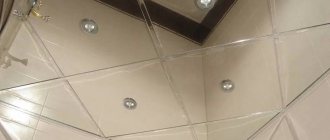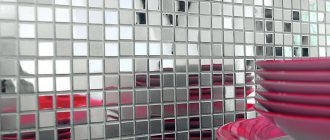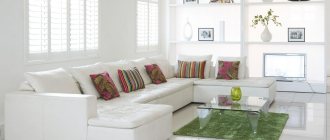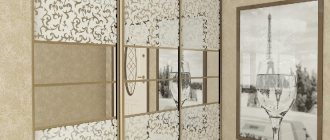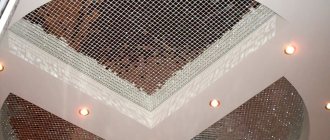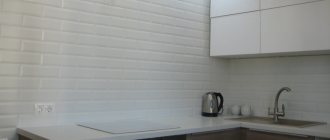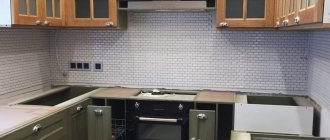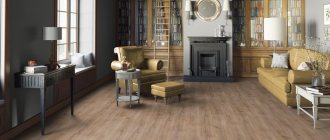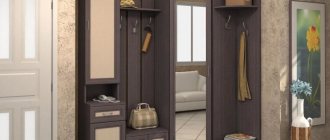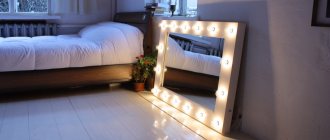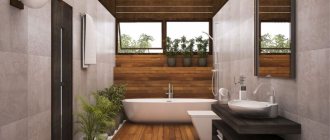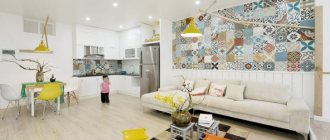The photo shows the interior of a living room in a loft style; one of the walls is decorated with mirror tiles.
The reflective surface can be applied to almost any material - plastic, foil, ceramic, polymer or metal plates. In addition, the metal can be processed in such a way that it will have a mirror effect without additional coating.
Types of mirror tiles
Interior tiles with a reflective surface are usually made of either glass or durable plastic such as polystyrene. There are a huge number of manufacturing options:
- flat and smooth surface, such tiles create almost invisible joints;
- tiles with bevel, it is convenient to install;
- tiles with an effect that imitates metal, for example, gold, silver, chrome or polished bronze;
- tinted, having a faint tint;
- ornamented tiles (have a pattern obtained by sandblasting);
- decorative, decorated with drawings or having three-dimensional images or a textured surface.
What to combine mirror mosaic with?
Mirror mosaic is a universal decorative item that looks good in combination with many materials. Most often it is combined with glass or plastic mosaics and ceramic tiles.
The photo shows an elegant combination of light tiles and mirror details that resemble streams of water and add individuality to an ordinary interior.
Interior design features
The main thing when using a mirror surface is to maintain a sense of proportion. Too many reflective elements can negatively affect the nervous system. In addition, mirrors located opposite each other create the feeling of a tunnel going into infinity, which has a depressing effect on the psyche.
You can use tiles on two surfaces that are adjacent to each other, for example, one of the walls and the ceiling. However, even in this option, it is better for the tiles to be different: for example, on the wall it can be patterned, and on the ceiling it can be smooth, but with a tint.
Tip: In the interior, designers recommend combining areas decorated with mirror elements so that they differ in the degree of reflection and are at different levels relative to the observer. However, do not forget that light sources reflected in mirrors can negatively affect your vision and tire you. A good solution is to use frosted lamps or LEDs next to the mirror elements.
The ceiling, lined with mirror tiles, visually rises, increasing the height of the room. However, at the same time, this gives rise to the effect of an “inverted” room, especially if the entire ceiling area is lined with mirrors. Therefore, usually the mirror surface only partially occupies it. An important point is also what will be reflected in the ceiling - therefore, increased demands are placed on the interior of the room in general and on the flooring in particular.
Visually “raising” the ceiling with the help of mirror tiles makes sense in small rooms; the interior of a large room with high ceilings will look too cold and empty with such a finish.
Mirror floors are used less often in interiors. It is very important that what is reflected in them does not spoil the interior. In addition, if there is a mirrored floor in the apartment, the use of other reflective materials is not recommended. Do not confuse a mirror floor with “mirror” parquet. The latter is just ordinary parquet, coated with reflective varnish on top.
Mirror tiles in the interior go well with regular tiles, and the joints between them can be covered with moldings made of plaster or wood.
Mirror mosaic finishing options
Mirror mosaic is a truly universal material. It looks great on any surface: walls, ceilings and even interior items - furniture, fireplaces, mirrors. Adding mirror strips or inserts to the decoration will help transform the space of the apartment. Installation of tiles attached to the mesh is easy: the canvas is glued to the prepared surface. The grout can be white or graphite in color.
Kitchen apron
Because of its advantages, a mirror panel is often installed in the kitchen as an apron. This decor not only expands the space, but also protects the wall from dirt in the cooking area.
Walls
The surface finished with mirror mosaic is very practical, so it can be tiled in any corner of the house: kitchen, bedroom, living room. This decor looks great in hallways and can also decorate a bathroom.
The photo shows a bathroom in a minimalist style. The interior is enlivened by a wall of combined mosaic tiles that form a pattern.
Ceiling
It is recommended to decorate part of the ceiling with mosaic tiles to avoid overcrowding the interior. The area where the chandelier hangs is successfully decorated: its mirror surface reflects light and casts picturesque reflections on the walls. The mosaic edging laid around the perimeter of the ceiling looks original - it increases the amount of daylight coming from the windows.
Wardrobe facade
You can decorate almost any furniture with mirror fragments: tables, cabinets, kitchen islands, bar counters. The façade of the wardrobe, decorated with mosaics, looks extraordinary.
The photo shows a wardrobe with a door decorated with mirror squares. Diagonal laying echoes the floor covering, and beveled edges make the interior richer.
Frame for a picture or mirror
Interior items decorated with mosaics always look stylish and original. You can make such a mirror with your own hands by gluing mosaic pieces to any surface.
Niche
A niche decorated with mini-mirrors will become the “highlight” of the interior, visually enlarging it and attracting the attention of guests.
The photo shows a fragment of a kitchen with a niche decorated with thin shiny stripes that visually deepen the space.
Fireplace
Mosaic is resistant to high temperatures and, despite its external fragility, is very durable. This coating is ideal for cladding a fireplace portal.
Hallway design
The placement of mirrors in the entrance area is a requirement for convenience. Moreover, it is better if the person is completely reflected in it. Therefore, in the interior of the hallway, the use of mirror tiles on one of the walls would be quite appropriate.
Eastern traditions, in particular the teachings of Feng Shui, prohibit placing mirrors opposite the entrance; it is believed that in this way money flows cannot enter the house. It is better to tile the side walls - it will replace the traditional mirror. If the hallway is long and narrow enough, you should not lay out the back wall with mirror tiles - the room will seem even longer and narrower, which does not add coziness.
Advantages and disadvantages of a mirror apron
Why do you need a kitchen apron? First of all, to protect the kitchen walls from dirt - drops of grease, splashes, etc. Conventional wall coverings, such as plaster or wallpaper, are difficult to clean from greasy stains. In addition to its practical function, the apron also has a decorative function.
Advantages of a mirror apron:
- Mirror tiles for the kitchen are made of tempered glass - it is highly durable and is not afraid of temperature changes, humidity, or open fire.
- Since glass is not a porous material, drops of water, salt, dirt and soot do not exert their destructive mirror on it. Dirty stains will be visible on the mirror surface, but they can be easily washed off; all you need is a damp sponge with glass cleaner.
- The mirror is not afraid of household chemicals. The only chemical that can damage the material is hydrofluoric acid, but it is not used in everyday life.
- Mold and rot, which easily form at the joints of ceramic tiles, do not linger on the mirror. Since glass, as already mentioned, does not have pores or roughness, fungi and bacteria cannot multiply in it.
Disadvantages of mirror tiles:
- Tempered glass is less durable than ceramic tiles, but the difference is not that significant. Modern tempered glass is difficult to break with a hammer.
- You should be careful when choosing cleaning products. Glass will not tolerate any powders; they scratch the surface, which will greatly affect the appearance of the mirror kitchen .
Photo in the living room
If the living room is zoned with a multi-level ceiling, it would be appropriate to decorate some parts of it with mirror tiles. Another interior design idea is to completely tile one of the walls. This will expand the room and highlight its details.
You can also use the property of mirrors to double nearby objects. Place several indoor plants near the wall decorated with mirror materials - it will seem that there are many more of them. A glass display case with beautiful dishes, placed near a mirrored wall, will also “double.”
The photo shows a living room interior in a classic style; mirror surfaces help to visually enlarge a small space.
Mosaic tile design ideas and shapes
Modern mosaic is represented by a wide range. Types of mirror tiles differ in the type of processing, shape, shades and size.
- The edges of products are processed in different ways: the surface can be ground or polished. A bevel is also used, which gives the tiles additional volume.
- On sale there are not only square-shaped products, but also in the form of rhombuses, rectangles, and hexagonal honeycombs. Round tiles are particularly original.
- To diversify the usual “silver” mirror shade, manufacturers have learned to tint products to look like black mirror, bronze and gold.
The photo shows a bathroom in which the space is uniquely expanded due to combined mirror parts of different sizes.
The mosaic also differs in its size: from small (10x10 mm) to large (several centimeters in area).
Kitchen decoration
Panels made of mirror tiles or mosaics are appropriate both in the interior of the kitchen and in the dining area. Disadvantage: in rooms where food is prepared, all surfaces quickly become covered with a greasy coating, especially if there is no hood, and this coating is especially noticeable.
Production and technical specifications
Mirror tiles are made differently from classic ceramic tiles. This is due to the structural features of the product. The manufacturing process of such material is automated. The warp is made by cutting large sheets into uniform segments of the desired shape and size. The mirror side is made using the damping method. Crystalline substances are added to glass melted at high temperatures, due to which a characteristic shine appears. The cut fragments are processed on a grinding machine and polished.
If the tiles are made from polystyrene, they are much easier to cut and paint. However, this option is no longer so environmentally friendly and safe. All designs and ornaments on surfaces are applied by sandblasting.
Bedroom ideas
In the bedroom interior, it is recommended not to use mirror tiles opposite the bed and on the ceiling. Finish one of the front walls or the wall behind the headboard if you want to get a modern and aesthetic interior. However, for some people, having large reflective pieces in the bedroom can make you feel awkward, so start by placing a large mirror against the wall and assess how comfortable it is for you.
Children's room
Mirror tiles are inappropriate in the interior of a children's room - they break quite easily, which can lead to injuries. Instead, you can use a self-adhesive film on the ceiling - it will reflect the weak light of the night light and create soft diffused lighting for those children who do not like to sleep in a dark room.
Design tricks of a mirrored kitchen
Mirror tiles create the illusion of expanded space - a long-known technique in interior design. However, even here there are some nuances that must be taken into account. An apron in the kitchen usually occupies a relatively small space between wall cabinets and cabinets on the floor. The work area, thanks to the large mirror, looks like a single whole. You should not place mirror tiles only near the stove, for example, or above the sink - this will only “cut up” the space.
Another nuance: a mirrored apron can visually give furniture a more elegant look, making the space between the upper and lower cabinets more elongated.
If the situation is the opposite, and the cabinets are already located at a fairly large distance from each other, a mirrored apron can ruin everything. The mirror, visually enlarging the space, will create the feeling that the cabinets are separated from each other and are not a single ensemble. To avoid this effect, the mirror is combined with the same cladding that was used to decorate the remaining walls of the kitchen.
The ability of mirrors to reflect light will allow you to effectively distribute lighting in the kitchen space. Sometimes, instead of lamps in the mirrored apron area, ordinary lighting is enough.
The surface of the mirrored apron can have different shades; this should also be taken into account when decorating the kitchen. Light glass, like gold glass, is usually combined with wood. Dark tinted mirrors will fit perfectly into a high-tech kitchen.
Note: since the mirror reflects not only the light, but also everything around it, it is highly recommended to put all the dishes in the cabinets, otherwise the kitchen will seem like a constant mess.
Bathroom
In the interior of bathrooms and toilets, mirror elements can look very impressive. These are those rooms in which almost the entire surface of the walls can be lined with it. The only inconvenience is that when using hot water, the tiles fog up.
Passage areas
A corridor, a passage from room to room, or a staircase in a house are not the most illuminated places, so a mirror surface, especially with proper lighting, would be very appropriate. The original option is to decorate the risers with tiles. In this case, the steps seem to be floating in the air, and the staircase itself is very light.
How to make it yourself
If there is an unfilled area of any surface in your home, try to revive it yourself with a mirror mosaic made by yourself. You can involve the whole family, especially children, in this exciting process.
To do this, you will need an old mirror, which must be cut into pieces using a glass cutter. These can be fragments of different sizes and shapes - a matter of your taste and your imagination. The main thing is to fold them correctly to create a beautiful ornament.
Each piece should be sanded with an emery block. Sand the corners especially carefully so as not to injure yourself during the work. The result should be a lot of mirrored pieces with dull edges. To glue a homemade mosaic you will need several different tools:
- PVA glue or “liquid nails”. The latter are better, because they will not let it break;
- putty;
- plasticine.
In addition, you will need latex putty, a silicone tube with a tip, and a gun for squeezing the composition out of the tube.
How to glue on the wall
If you simply coat the fragment with PVA glue and attach it to the surface, it will not stick. Therefore, we do this: put a piece of plasticine or putty on the back side of the mirror chip, press it down and make a recess into which we add a drop of glue. Press the piece to the surface. While the plasticine holds the mirror, the glue has time to dry. You need to try not to get any excess on the mirror, otherwise its reflective layer will be damaged.
After laying out the mosaic pattern over the entire surface, wait a day or two for the glue to dry completely. Then start grouting the joints. This procedure is performed using putty. If the mirror pieces are of the same shape, then grouting can be done using a small rubber spatula. Otherwise, use an empty silicone tube, which is filled with putty. It is better to squeeze out the composition with a special gun. But if you don’t have one, then the handle of a regular hammer will do.
Finally, remove excess putty with your index finger. When everything is dry, wipe the mosaic with a damp sponge and then with a wad of regular newspaper.
A composition made of a mirror mosaic can be decorated with additional elements: beads, beads, sparkles, etc. They just need to be pressed into the putty that has not yet cooled down.
Mirror mosaic can be easily dismantled if necessary. Moreover, the pieces can be reused.
Country style house.
Read this article on how to paint plasterboard walls.
Types of putties: https://trendsdesign.ru/materialy/shpaklevka/osobennosti-shpatlevaniya.html
